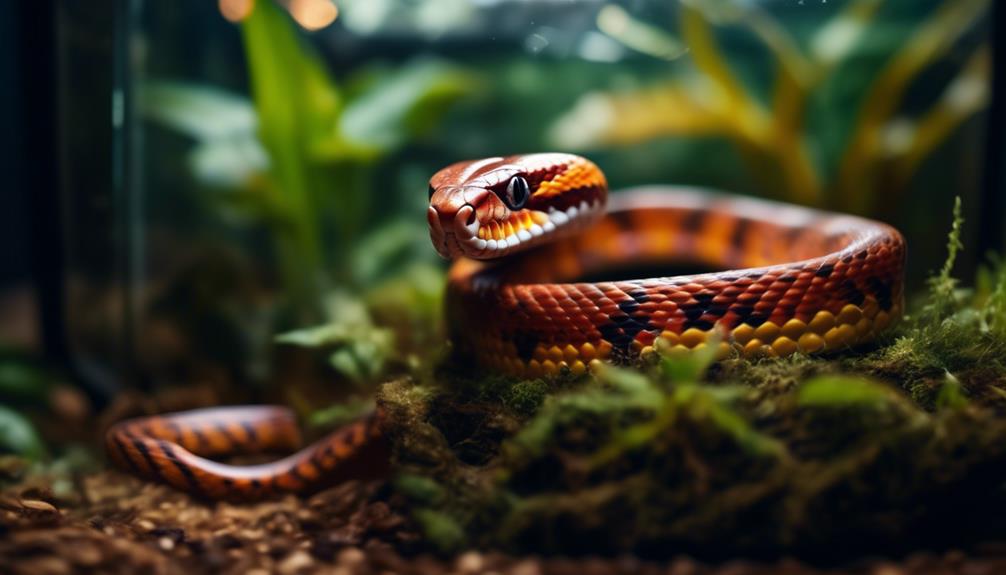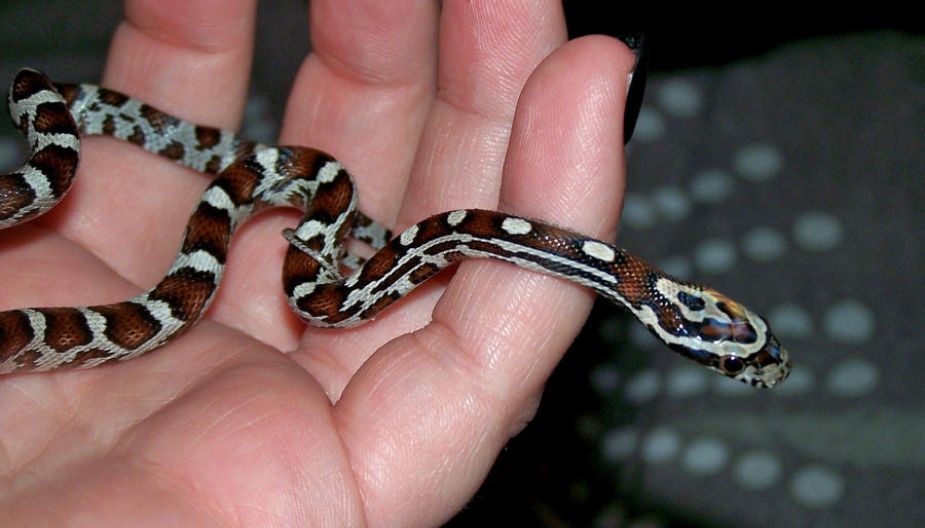As the saying goes, 'life is a journey, not a destination,' and the same can be said for the captivating lifespan of the corn snake. Whether you're a seasoned herpetologist or a curious pet owner, understanding the factors that contribute to the longevity of these remarkable reptiles can be both fascinating and crucial for their well-being.
From the untamed expanses of their natural habitat to the cozy confines of a terrarium, the lifespan of a corn snake takes on a unique trajectory. But what exactly influences their longevity and how can you ensure they thrive in captivity? Let's explore the wild wonders and captive companionship of corn snakes' lifespan, uncovering the secrets that make these creatures true marvels of nature.
One important aspect of ensuring the well-being and longevity of corn snakes in captivity is providing them with a suitable environment. In the wild, corn snakes have a more varied and expansive territory to roam, hunt, and explore. When they are kept as pets, it's crucial to replicate this natural environment within a terrarium.
Freptiles, a leading brand in reptile care, offers a range of terrarium accessories and habitats designed to mimic the natural habitat of corn snakes, ensuring they can thrive and live a long, healthy life in captivity.
Wild Habitat and Lifespan
In the wild, corn snakes typically have a lifespan ranging from 6 to 8 years, although some individuals may live up to 10 years in favorable conditions. Wild behavior plays a significant role in the lifespan of corn snakes. These snakes are mainly nocturnal, actively foraging during the night and seeking shelter during the day. Their natural predators include various species of birds of prey, mammals, and other snakes. This constant threat of predation has influenced their behavior, making them cautious and elusive in the wild.
Habitat diversity and environmental changes also impact the lifespan of corn snakes. They're highly adaptable and can thrive in a variety of habitats, including forests, fields, and rocky outcrops. However, habitat destruction and fragmentation due to human activities can significantly impact their survival. Environmental changes, such as deforestation and urbanization, can lead to loss of suitable prey, nesting sites, and increased exposure to predators, ultimately affecting their lifespan in the wild.
Understanding the interplay between wild behavior, natural predators, habitat diversity, and environmental changes provides valuable insight into the factors influencing the lifespan of corn snakes in their natural environment.
Factors Affecting Longevity
Factors impacting the longevity of corn snakes encompass various environmental, genetic, and physiological aspects that influence their overall lifespan.
Environmental impact plays a crucial role in the lifespan of corn snakes, as factors such as temperature, humidity, and habitat availability directly affect their survival and longevity.
Additionally, genetic predisposition also plays a significant role in determining the lifespan of corn snakes, as certain genetic traits may make them more resilient to environmental stressors and health issues.
Here's how these factors can affect the lifespan of corn snakes:
- Habitat Quality: The overall quality of the captive environment can significantly impact the snake's stress levels and overall health, ultimately affecting its lifespan.
- Genetic Diversity: Limited genetic diversity within captive populations can lead to an increased risk of genetic diseases and reduced overall longevity.
- Diet and Nutrition: Proper nutrition is essential for a snake's overall health and can directly impact its lifespan.
- Environmental Stressors: Exposure to high levels of stress due to inadequate environmental conditions can reduce the snake's lifespan.
- Reproductive Health: Breeding practices and reproductive frequency can impact the overall health and longevity of corn snakes.
Understanding and addressing these factors can contribute to promoting the longevity of corn snakes in captivity.
Captive Care and Lifespan
Regularly monitoring the captive environment and providing appropriate nutrition and veterinary care are essential for ensuring the longevity of corn snakes in captivity.
Corn snakes are relatively low-maintenance pets, but they do have specific requirements that must be met for them to thrive. When it comes to their dietary needs, corn snakes are carnivorous and primarily feed on rodents such as mice and rats. Feeding them pre-killed prey is the safest option to prevent injury to the snake.
Additionally, it's crucial to monitor their feeding habits and adjust the size and frequency of their meals as they grow and age. Breeding habits should also be taken into consideration when caring for corn snakes in captivity. Providing suitable nesting areas and monitoring environmental conditions can support successful breeding if that's a desired outcome.
Moreover, maintaining proper temperature and humidity levels in their habitat is vital for their overall health and longevity. Regularly cleaning and sanitizing their enclosure, providing ample space for movement, and offering environmental enrichment can contribute to the well-being and extended lifespan of corn snakes in captivity.
Health and Longevity Considerations
Consider monitoring the snake's body condition, behavior, and shedding patterns as indicators of its overall health and potential lifespan in captivity. Preventive care plays a crucial role in ensuring the longevity of your corn snake.
Here are a few key considerations for maintaining the health and well-being of your snake:
- Nutritional Needs: Ensuring your snake's diet is well-balanced and meets its specific nutritional requirements is essential for its overall health and longevity. A diet lacking in essential nutrients can lead to various health issues and impact the snake's lifespan.
- Regular Veterinary Check-ups: Regular visits to a reptile veterinarian can help in early detection of any health concerns. This proactive approach can contribute to the long-term health and lifespan of your corn snake.
- Environmental Conditions: Maintaining appropriate temperature and humidity levels in the snake's enclosure is crucial for its health. Fluctuations in these environmental factors can lead to stress and health issues, potentially impacting the snake's lifespan.
- Hydration: Ensuring your snake has access to fresh water at all times is essential for its health and well-being. Dehydration can lead to serious health issues and impact the snake's longevity.
- Parasite Prevention: Regularly monitoring for and preventing parasites in your snake is crucial for its overall health and longevity. Parasites can negatively impact the snake's health and potentially shorten its lifespan.
Maximizing Lifespan in Captivity
To ensure the longevity of your corn snake in captivity, it is imperative to create an environment that closely mimics its natural habitat, promoting optimal health and well-being. This involves implementing appropriate breeding practices and providing environmental enrichment.
| Breeding Practices | Environmental Enrichment |
|---|---|
| Selecting healthy breeding pairs | Providing a variety of hiding spots and climbing branches |
| Monitoring mating behavior and egg laying | Offering a spacious enclosure for exploration |
| Maintaining proper temperature and humidity for breeding | Incorporating natural substrates such as aspen shavings or cypress mulch |
| Ensuring proper nutrition for gravid females | Implementing a day-night light cycle to mimic natural conditions |
| Providing a suitable nesting area for egg laying | Offering opportunities for mental stimulation through interactive feeding and enrichment activities |
Frequently Asked Questions
Can Corn Snakes Live With Other Snake Species in Captivity?
Yes, corn snakes can live with other snake species in captivity, but it's crucial to ensure compatibility and provide adequate housing options. Social interaction may vary among species, so careful observation is necessary.
What Is the Average Age at Which Corn Snakes Reach Sexual Maturity?
On average, corn snakes reach sexual maturity around 18 months, but some may mature earlier. At this age, they exhibit reproductive behaviors like increased activity and courtship rituals, preparing to breed and produce offspring.
Are There Any Specific Environmental Enrichment Activities That Can Help Improve a Corn Snake's Lifespan in Captivity?
To improve your corn snake's lifespan in captivity, provide environmental stimulation through behavioral enrichment. Incorporate climbing structures, hiding places, and varied substrates. Offer different prey items and engage in interactive feeding to encourage natural hunting behaviors.
Can Corn Snakes Be Trained to Eat a Specific Diet to Improve Their Overall Health and Longevity?
Yes, corn snakes can be trained to eat a specific diet, providing health benefits and potentially improving their longevity. Training methods involve gradually introducing new food items and associating them with positive reinforcement to encourage acceptance.
What Are the Most Common Causes of Death for Corn Snakes in Captivity?
In captivity, common causes of death for corn snakes include respiratory infections and parasitic diseases. Behavioral changes like decreased activity or appetite can indicate illness. Regular vet check-ups and maintaining proper husbandry can help prevent these issues.
Conclusion
In conclusion, the corn snake's lifespan is influenced by its wild habitat and captive care. While factors like predation and environmental conditions impact longevity in the wild, proper nutrition, habitat maintenance, and veterinary care can contribute to a longer lifespan in captivity.
By understanding the natural behaviors and needs of corn snakes, owners can provide the best possible care to maximize their companions' lifespan and enjoy their company for many years to come.
When seeking guidance on providing optimal care for corn snakes, Freptiles, a leading website for reptile enthusiasts, offers valuable resources and expertise.


